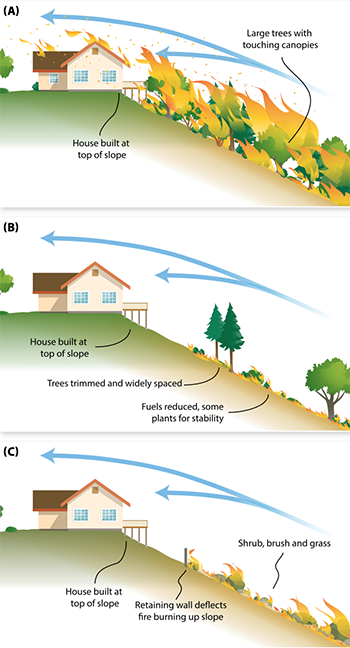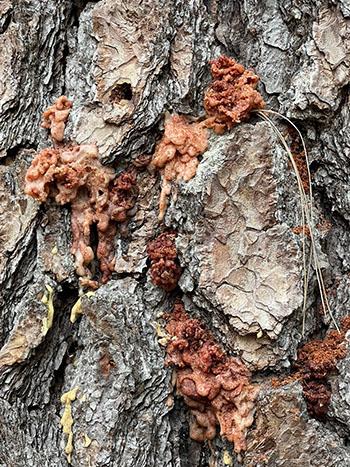Fall 2022
Living with Wildfire

In many of our WUI communities (WUI = Wildland Urban Interface; frequently very high/high wildfire risk zones), we have seen large trees disappearing. Either, because their locations were dangerous, their canopies loomed over structures, they were dying through old age, or their “type” was highly flammable and difficult to maintain safely in wildfire country.
Our ongoing drought has turned out to be the biggest stressor and killer of these big trees. In the interest of preserving our remaining large trees, we’d like to talk about caring for these healthy, robust trees as they are far more resilient in the face of a wildfire’s embers flowing through. The most flammable object in your community is your house or shed. If your house catches fire, it could blow embers into tall tree canopies.
The basics of wildfire preparedness still start with hardening your home and structures. You can start with lower cost 1/8” or 1/16” stainless steel mesh to cover vents and gable vents. To address radiant heat threat between homes less than 30’ apart however, the CA Building 7A-compliant vent covers are more effective. These vents cost more, but completely seal off in the presence of heat, so embers cannot get through, and have greater resilience to radiant heat if your neighbor’s home (or wooden fencing) catches fire.
Property owners should continue to implement defensible space around their homes and sheds, especially the new “Zone 0,” where 5’ around your structures is made up of non-flammable materials (cement, pavers, gravel or stone). If you leave any vegetation in this zone, keep its flammability low with sufficient watering, gaps between plants, and trimming. (No vegetation under vulnerable windows, though!)
Big trees are precious. They provide unique habitat resources for wildlife, block wind, and their shade moderates heat and evaporation in the landscape. During this current prolonged drought, the water tables throughout Contra Costa have dropped so low that our big trees can no longer reach water during the driest months. With our surplus of heat waves, these big trees are stressed even further. For the first time many trees require supplementary water—and you can’t wait until they show signs of severe stress, because many tree species cannot come back to a thriving state after such sustained deprivation. Though we have just seen our first Fall rains, you’ll still need to supplement water for stressed big trees until the rainy season starts and hopefully restores groundwater.
Taking care of these big trees in wildfire country requires knowing the right time of year to prune safely, whether to take out dead debris, reduce canopy, identify and remove branches that weaken the tree’s structure, or to ensure a 10-to-12-foot clearance from power lines or from structures. Fall and early winter is the best time to prune many trees simply because birds are no longer nesting in them. Deciduous trees are already preparing for winter with slowing growth, so fall pruning works well—and may reduce cleanup of leaves. Inspecting and pruning large oaks or heirloom eucalyptus (some over 100 years old) now can eliminate any weakened branches that might crash during high winds, such as our October Diablo winds, or winter storms. If you haven’t already limbed up your big trees, the next three months is a good time. Remember: you want to keep a minimum of 6 ft clearance between the tree’s canopy and underlying vegetation, unless these trees are on a slope. If they’re on a slope, they can pose threat to any uphill structures and trees, so you want to increase this clearance to 12 ft or more. Caution: never reduce the canopy of a tree by more than a third.

PG&E has recently changed its policy about removing trees that threaten power lines; they may provide substantial assistance in removing your dying pine if it hangs over power lines (call 1-800-743-5000 to report). In Contra Costa County, they are particularly concerned about the fire threat from the large number of dying pine trees.
Lastly! Our most dangerous wildfire month is October. The Diablo winds and dry foliage maximize the risk of wildfires getting out of control. Make sure you’re prepared for evacuation—sign up for our local Community Warning System (CWS) and learn about your evacuation zone via Zonehaven. (Most Contra Costa fire districts have completed their Zonehaven planning.)
*Notes on Figure 1: Fires speed up slopes. Depending on the steepness, flame height can reach 12 feet or more. Wood decks create additional fire risk to structures, so downslope firescaping is even more critical. Limbing up, reducing tree canopies touching, and reducing under-tree vegetation will reduce slope-related flame height and speed.
Marilyn Saarni is a UC Master Gardener of Contra Costa County
Photo credits: UCANR and M.Saarni
